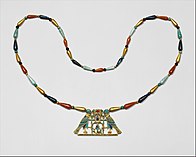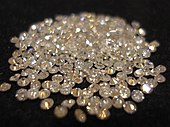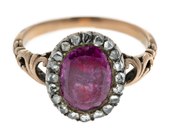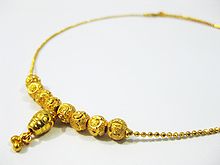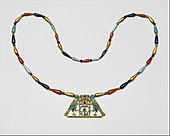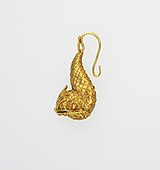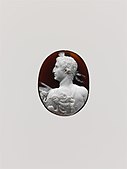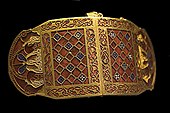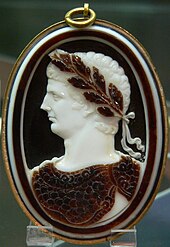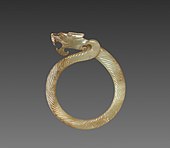A | B | C | D | E | F | G | H | CH | I | J | K | L | M | N | O | P | Q | R | S | T | U | V | W | X | Y | Z | 0 | 1 | 2 | 3 | 4 | 5 | 6 | 7 | 8 | 9
Jewellery (Commonwealth English) or jewelry (American English) consists of decorative items worn for personal adornment, such as brooches, rings, necklaces, earrings, pendants, bracelets, and cufflinks. Jewellery may be attached to the body or the clothes. From a western perspective, the term is restricted to durable ornaments, excluding flowers for example. For many centuries metal such as gold often combined with gemstones, has been the normal material for jewellery, but other materials such as glass, shells and other plant materials may be used.
Jewellery is one of the oldest types of archaeological artefact – with 100,000-year-old beads made from Nassarius shells thought to be the oldest known jewellery.[1] The basic forms of jewellery vary between cultures but are often extremely long-lived; in European cultures the most common forms of jewellery listed above have persisted since ancient times, while other forms such as adornments for the nose or ankle, important in other cultures, are much less common.
Jewellery may be made from a wide range of materials. Gemstones and similar materials such as amber and coral, precious metals, beads, and shells have been widely used, and enamel has often been important. In most cultures jewellery can be understood as a status symbol, for its material properties, its patterns, or for meaningful symbols. Jewellery has been made to adorn nearly every body part, from hairpins to toe rings, and even genital jewellery. In modern European culture the amount worn by adult males is relatively low compared with other cultures and other periods in European culture.
The word jewellery itself is derived from the word jewel, which was anglicised from the Old French "jouel",[2] and beyond that, to the Latin word "jocale", meaning plaything. In British English, Indian English, New Zealand English, Hiberno-English, Australian English, and South African English it is spelled jewellery, while the spelling is jewelry in American English.[3] Both are used in Canadian English, though jewellery prevails by a two to one margin. In French and a few other European languages the equivalent term, joaillerie, may also cover decorated metalwork in precious metal such as objets d'art and church items, not just objects worn on the person.
Form and function

Humans have used jewellery for a number of different reasons:
- functional, generally to fix clothing or hair in place.
- as a marker of social status and personal status, as with a wedding ring
- as a signifier of some form of affiliation, whether ethnic, religious or social
- to provide talismanic protection (in the form of amulets)[4]
- as an artistic display
- as a carrier or symbol of personal meaning – such as love, mourning, a personal milestone or even luck
- considered it as a good investment
- superstition[5]
Most[quantify] cultures at some point have had a practice of keeping large amounts of wealth stored in the form of jewellery. Numerous cultures store wedding dowries in the form of jewellery or make jewellery as a means to store or display coins. Alternatively, jewellery has been used as a currency or trade good.[6] an example being the use of slave beads.[7]
Many items of jewellery, such as brooches and buckles, originated as purely functional items, but evolved into decorative items as their functional requirement diminished.[8]
Jewellery can symbolise group membership (as in the case, of the Christian crucifix or the Jewish Star of David) or status (as in the case of chains of office, or the Western practice of married people wearing wedding rings).
Wearing of amulets and devotional medals to provide protection or to ward off evil is common in some cultures. These may take the form of symbols (such as the ankh), stones, plants, animals, body parts (such as the Khamsa), or glyphs (such as stylised versions of the Throne Verse in Islamic art).[9]
Materials and methods

In creating jewellery, gemstones, coins, or other precious items are often used, and they are typically set into precious metals. Platinum alloys range from 900 (90% pure) to 950 (95% pure). The silver used in jewellery is usually sterling silver, or 92.5% fine silver. In costume jewellery, stainless steel findings are sometimes used.
Other commonly used materials include glass, such as fused-glass or enamel; wood, often carved or turned; shells and other natural animal substances such as bone and ivory; natural clay; polymer clay; Hemp and other twines have been used as well to create jewellery that has more of a natural feel. However, any inclusion of lead or lead solder will give a British Assay office (the body which gives U.K. jewellery its stamp of approval, the Hallmark) the right to destroy the piece, however it is very rare for the assay office to do so.
Beads are frequently used in jewellery. These may be made of glass, gemstones, metal, wood, shells, clay and polymer clay. Beaded jewellery commonly encompasses necklaces, bracelets, earrings, belts and rings. Beads may be large or small; the smallest type of beads used are known as seed beads, these are the beads used for the "woven" style of beaded jewellery. Seed beads are also used in an embroidery technique where they are sewn onto fabric backings to create broad collar neck pieces and beaded bracelets. Bead embroidery, a popular type of handwork during the Victorian era, is enjoying a renaissance in modern jewellery making. Beading, or beadwork, is also very popular in many African and indigenous North American cultures.
Silversmiths, goldsmiths, and lapidaries use methods including forging, casting, soldering or welding, cutting, carving and "cold-joining" (using adhesives, staples and rivets to assemble parts).[10]
Diamonds
Diamonds were first mined in India.[11] Pliny may have mentioned them, although there is some debate as to the exact nature of the stone he referred to as Adamas.[12] In 2005, Australia, Botswana, Russia and Canada ranked among the primary sources of gemstone diamond production.[13] There are negative consequences of the diamond trade in certain areas. Diamonds mined during the recent civil wars in Angola, Ivory Coast, Sierra Leone, and other nations have been labelled as blood diamonds when they are mined in a war zone and sold to finance an insurgency.[citation needed]
The British crown jewels contain the Cullinan Diamond, part of the largest gem-quality rough diamond ever found (1905), at 3,106.75 carats (621.35 g).
Now popular in engagement rings, this usage dates back to the marriage of Maximilian I to Mary of Burgundy in 1477.[14]
A popular style is the diamond solitaire, which features a single large diamond mounted prominently.[15] Within solitaire, there are 3 categories in which a ring can be classified into: prong, bezel and tension setting.[16]
Other gemstones
Many precious and semiprecious stones are used for jewellery. Among them are:
- Amber
- Amber, an ancient organic gemstone, is composed of tree resin that has hardened over time. The stone must be at least one million years old to be classified as amber, and some amber can be up to 120 million years old.
- Amethyst
- Amethyst has historically been the most prized gemstone in the quartz family. It is treasured for its purple hue, which can range in tone from light to dark.
- Emerald
- Emeralds are one of the three main precious gemstones (along with rubies and sapphires) and are known for their fine green to bluish green colour. They have been treasured throughout history, and some historians report that the Egyptians mined emerald as early as 3500 BC.
- Jade
- Jade is most commonly associated with the colour green but can come in a number of other colours as well. Jade is closely linked to Asian culture, history, and tradition, and is sometimes referred to as the stone of heaven.
- Jasper
- Jasper is a gemstone of the chalcedony family that comes in a variety of colours. Often, jasper will feature unique and interesting patterns within the coloured stone. Picture jasper is a type of jasper known for the colours (often beiges and browns) and swirls in the stone's pattern.
- Quartz
- Quartz refers to a family of crystalline gemstones of various colours and sizes. Among the well-known types of quartz are rose quartz (which has a delicate pink colour), and smoky quartz (which comes in a variety of shades of translucent brown). A number of other gemstones, such as Amethyst and Citrine, are also part of the quartz family. Rutilated quartz is a popular type of quartz containing needle-like inclusions.
- Ruby
- Rubies are known for their intense red colour and are among the most highly valued precious gemstones. Rubies have been treasured for millennia. In Sanskrit, the word for ruby is ratnaraj, meaning king of precious stones.
- Sapphire
- The most popular form of sapphire is blue sapphire, which is known for its medium to deep blue colour and strong saturation. Fancy sapphires of various colours are also available. In the United States, blue sapphire tends to be the most popular and most affordable of the three major precious gemstones (emerald, ruby, and sapphire).
- Turquoise
- Turquoise is found in only a few places on earth, and the world's largest turquoise-producing region is the southwest United States. Turquoise is prized for its attractive colour, most often an intense medium blue or a greenish blue, and its ancient heritage. Turquoise is used in a great variety of jewellery styles. It is perhaps most closely associated with southwest and Native American jewellery, but it is also used in many sleek, modern styles. Some turquoise contains a matrix of dark brown markings, which provides an interesting contrast to the gemstone's bright blue colour.
Some gemstones (like pearls, coral, and amber) are classified as organic, meaning that they are produced by living organisms. Others are inorganic, meaning that they are generally composed of and arise from minerals.
Some gems, for example, amethyst, have become less valued as methods of extracting and importing them have progressed. Some man-made gems can serve in place of natural gems, such as cubic zirconia, which can be used in place of diamond.[17]
Metal finishes
For platinum, gold, and silver jewellery, there are many techniques to create finishes. The most common are high-polish, satin/matte, brushed, and hammered. High-polished jewellery is the most common and gives the metal a highly reflective, shiny look. Satin, or matte finish reduces the shine and reflection of the jewellery, and this is commonly used to accentuate gemstones such as diamonds. Brushed finishes give the jewellery a textured look and are created by brushing a material (similar to sandpaper) against the metal, leaving "brush strokes". Hammered finishes are typically created by using a rounded steel hammer and hammering the jewellery to give it a wavy texture.
Some jewellery is plated to give it a shiny, reflective look or to achieve a desired colour. Sterling silver jewellery may be plated with a thin layer of 0.999 fine silver (a process known as flashing) or may be plated with rhodium or gold. Base metal costume jewellery may also be plated with silver, gold, or rhodium for a more attractive finish.
Impact on society
Jewellery has been used to denote status. In ancient Rome, only certain ranks could wear rings and[18] later, sumptuary laws dictated who could wear what type of jewellery. This was also based on rank of the citizens of that time.
Cultural dictates have also played a significant role. For example, the wearing of earrings by Western men was considered effeminate in the 19th century and early 20th century. More recently, the display of body jewellery, such as piercings, has become a mark of acceptance or seen as a badge of courage within some groups but is completely rejected in others. Likewise, hip hop culture has popularised the slang term bling-bling, which refers to ostentatious display of jewellery by men or women.
Conversely, the jewellery industry in the early 20th century launched a campaign to popularise wedding rings for men, which caught on, as well as engagement rings for men, which did not, going so far as to create a false history and claim that the practice had medieval roots. By the mid-1940s, 85% of weddings in the U.S. featured a double-ring ceremony, up from 15% in the 1920s.[19]
Some religions have specific rules or traditions surrounding jewellery (or even prohibiting it) and many religions have edicts against excessive display. Islam, for instance, considers the wearing of gold by men as Haraam.[20] The majority of Islamic jewellery was in the form of bridal dowries, and traditionally was not handed down from generation to generation; instead, on a woman's death it was sold at the souk and recycled or sold to passers-by. Islamic jewellery from before the 19th century is thus exceedingly rare.[21]
Some Christian denominations forbid the use of jewellery by both men and women, including Amish-Mennonites and Holiness churches. The New Testament of the Bible gives injunctions against the wearing of gold, in the writings of the apostles Paul and Peter, and Revelations, describes "the great whore", or false religious system, as being "decked with gold and precious stones and pearls, having a golden cup in her hand." (Rev. 17:4)
History
The history of jewellery is long and goes back many years, with many different uses among different cultures. It has endured for thousands of years and has provided various insights into how ancient cultures worked.
Prehistory
The earliest known Jewellery was actually created not by humans (Homo sapiens) but by Neanderthal living in Europe. Specifically, perforated beads made from small sea shells have been found dating to 115,000 years ago in the Cueva de los Aviones, a cave along the southeast coast of Spain. Later in Kenya, at Enkapune Ya Muto, beads made from perforated ostrich egg shells have been dated to more than 40,000 years ago. In Russia, a stone bracelet and marble ring are attributed to a similar age.[22]
Later, the European early modern humans had crude necklaces and bracelets of bone, teeth, berries, and stone hung on pieces of string or animal sinew, or pieces of carved bone used to secure clothing together. In some cases, jewellery had shell or mother-of-pearl pieces. A decorated engraved pendant (the Star Carr Pendant) dating to around 11,000 BC, and thought to be the oldest Mesolithic art in Britain, was found at the site of Star Carr in North Yorkshire in 2015.[23] In southern Russia, carved bracelets made of mammoth tusk have been found. The Venus of Hohle Fels features a perforation at the top, showing that it was intended to be worn as a pendant.
Around seven-thousand years ago, the first sign of copper jewellery was seen.[8] In October 2012 the Museum of Ancient History in Lower Austria revealed that they had found a grave of a female jewellery worker – forcing archaeologists to take a fresh look at prehistoric gender roles after it appeared to be that of a female fine metal worker – a profession that was previously thought to have been carried out exclusively by men.[24]
String of beads; 3650–3100 BC; lapis lazuli (the blue beads) and travertine (the white beads) (Egyptian alabaster); length: 4.5 cm; by Naqada II or Naqada III cultures; Metropolitan Museum of Art (New York City)
String of beads; 3300–3100 BC; carnelian, garnet, quartz and glazed steatite; length: 20.5 cm; by Naqada III culture Metropolitan Museum of Art
Armlet with sun symbol; 16th-13th century BC (late Bronze Age); bronze; German National Museum (Nürnberg)
Necklace; probably 2600–1300 BC; carnelian, bone and stone; from Saruq Al Hadid (the United Arab Emirates)
Africa
Egypt
The first signs of established jewellery making in Ancient Egypt was around 3,000–5,000 years ago.[25] The Egyptians preferred the luxury, rarity, and workability of gold over other metals. In Predynastic Egypt jewellery soon began to symbolise political and religious power in the community. Although it was worn by wealthy Egyptians in life, it was also worn by them in death, with jewellery commonly placed among grave goods.
In conjunction with gold jewellery, Egyptians used coloured glass, along with semi-precious gems. The colour of the jewellery had significance. Green, for example, symbolised fertility. Lapis lazuli and silver had to be imported from beyond the country's borders.
Egyptian designs were most common in Phoenician jewellery. Also, ancient Turkish designs found in Persian jewellery suggest that trade between the Middle East and Europe was not uncommon. Women wore elaborate gold and silver pieces that were used in ceremonies.[25]
Pectoral (chest jewellery) of Tutankhamun; 1336–1327 BC (Reign of Tutankhamun); gold, silver and meteoric glass; height: 14.9 cm (5.9 in); Egyptian Museum (Cairo)
Pendant; circa 1069 BC; gold and turquoise; overall: 5.1 x 2.3 cm; Cleveland Museum of Art (Cleveland)
Signet ring; 664–525 BC; gold; diameter: 3 × 3.4 cm; British Museum (London)
Pectoral and necklace of Princess Sithathoriunet; 1887–1813 BC; gold, carnelian, lapis lazuli, turquoise, garnet & feldspar; height of the pectoral: 4.5 cm (1.8 in); Metropolitan Museum of Art (New York City)
Maghreb countries in North Africa
Jewellery of the Berber cultures is a style of traditional jewellery worn by women and girls in the rural areas of the Maghreb region in North Africa inhabited by indigenous Berber people (in Berber language: Amazigh, Imazighen, pl). Following long social and cultural traditions, the silversmiths of different ethnic Berber groups of Morocco, Algeria and neighbouring countries created intricate jewellery to adorn their women and that formed part of their ethnic identity. Traditional Berber jewellery was usually made of silver and includes elaborate brooches made of triangular plates and pins (fibula), originally used as clasps for garments, but also necklaces, bracelets, earrings and similar items.
Another major type is the so-called khmissa (local pronunciation of the Arabic word "khamsa" for the number "five"), which is called afus in the Berber language (Tamazight). This form represents the five fingers of the hand and is traditionally believed both by Muslims as well as Jewish people to protect against the Evil Eye.[26]
Europe and the Middle East
The first gold jewellery from Bulgaria
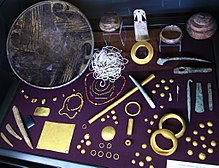
The oldest gold jewelry in the world is dating from 4,600 BC to 4,200 BC and was discovered in Europe, at the site of Varna Necropolis, near the Black Sea coast in Bulgaria.[27] Several prehistoric Bulgarian finds are considered no less old – the golden treasures of Hotnitsa, Durankulak, artifacts from the Kurgan settlement of Yunatsite near Pazardzhik, the golden treasure Sakar, as well as beads and gold jewellery found in the Kurgan settlement of Provadia – Solnitsata (“salt pit”). However, Varna gold is most often called the oldest since this treasure is the largest and most diverse.[28]
Mesopotamia

By approximately 5,000 years ago, jewellery-making had become a significant craft in the cities of Mesopotamia. The most significant archaeological evidence comes from the Royal Cemetery of Ur, where hundreds of burials dating 2900–2300 BC were unearthed; tombs such as that of Puabi contained a multitude of artefacts in gold, silver, and semi-precious stones, such as lapis lazuli crowns embellished with gold figurines, close-fitting collar necklaces, and jewel-headed pins. In Assyria, men and women both wore extensive amounts of jewellery, including amulets, ankle bracelets, heavy multi-strand necklaces, and cylinder seals.[29]
Jewellery in Mesopotamia tended to be manufactured from thin metal leaf and was set with large numbers of brightly coloured stones (chiefly agate, lapis, carnelian, and jasper). Favoured shapes included leaves, spirals, cones, and bunches of grapes. Jewellers created works both for human use and for adorning statues and idols. They employed a wide variety of sophisticated metalworking techniques, such as cloisonné, engraving, fine granulation, and filigree.[30]
Extensive and meticulously maintained records pertaining to the trade and manufacture of jewellery have also been unearthed throughout Mesopotamian archaeological sites. One record in the Mari royal archives, for example, gives the composition of various items of jewellery:
- 1 necklace of flat speckled chalcedony beads including: 34 flat speckled chalcedony bead, 35 gold fluted beads, in groups of five.
- 1 necklace of flat speckled chalcedony beads including: 39 flat speckled chalcedony beads, 41 fluted beads in a group that make up the hanging device.
- 1 necklace with rounded lapis lazuli beads including: 28 rounded lapis lazuli beads, 29 fluted beads for its clasp.[31]
Necklace; 2600–2500 BC; gold and lapis lazuli; length: 22.5 cm; Royal Cemetery at Ur (Iraq); Metropolitan Museum of Art
Pair of earrings with cuneiform inscriptions, 2093–2046 BC; gold; Sulaymaniyah Museum (Sulaymaniyah, Iraq)
Sumerian necklaces and headgear discovered in the royal (and individual) graves of the Royal Cemetery at Ur, showing the way they may have been worn, in British Museum (London)
Greece

The Greeks started using gold and gems in jewellery in 1600 BC, although beads shaped as shells and animals were produced widely in earlier times. Around 1500 BC, the main techniques of working gold in Greece included casting, twisting bars, and making wire.[33] Many of these sophisticated techniques were popular in the Mycenaean period, but unfortunately this skill was lost at the end of the Bronze Age. The forms and shapes of jewellery in ancient Greece such as the armring (13th century BC), brooch (10th century BC) and pins (7th century BC), have varied widely since the Bronze Age as well. Other forms of jewellery include wreaths, earrings, necklace and bracelets. A good example of the high quality that gold working techniques could achieve in Greece is the 'Gold Olive Wreath' (4th century BC), which is modeled on the type of wreath given as a prize for winners in athletic competitions like the Olympic Games. Jewellery dating from 600 to 475 BC is not well represented in the archaeological record, but after the Persian wars the quantity of jewellery again became more plentiful.[34] One particularly popular type of design at this time was a bracelet decorated with snake and animal-heads Because these bracelets used considerably more metal, many examples were made from bronze. By 300 BC, the Greeks had mastered making coloured jewellery and using amethysts, pearl, and emeralds. Also, the first signs of cameos appeared, with the Greeks creating them from Indian Sardonyx, a striped brown pink and cream agate stone. Greek jewellery was often simpler than in other cultures, with simple designs and workmanship. However, as time progressed, the designs grew in complexity and different materials were soon used.
Jewellery in Greece was hardly worn and was mostly used for public appearances or on special occasions. It was frequently given as a gift and was predominantly worn by women to show their wealth, social status, and beauty. The jewellery was often supposed to give the wearer protection from the "Evil Eye" or endowed the owner with supernatural powers, while others had a religious symbolism. Older pieces of jewellery that have been found were dedicated to the Gods.
They worked two styles of pieces: cast pieces and pieces hammered out of sheet metal. Fewer pieces of cast jewellery have been recovered. It was made by casting the metal onto two stone or clay moulds. The two halves were then joined together, and wax, followed by molten metal, was placed in the centre. This technique had been practised since the late Bronze Age. The more common form of jewellery was the hammered sheet type. Sheets of metal would be hammered to thickness and then soldered together. The inside of the two sheets would be filled with wax or another liquid to preserve the metal work. Different techniques, such as using a stamp or engraving, were then used to create motifs on the jewellery. Jewels may then be added to hollows or glass poured into special cavities on the surface.
The Greeks took much of their designs from outer origins, such as Asia, when Alexander the Great conquered part of it. In earlier designs, other European influences can also be detected. When Roman rule came to Greece, no change in jewellery designs was detected. However, by 27 BC, Greek designs were heavily influenced by the Roman culture. That is not to say that indigenous design did not thrive. Numerous polychrome butterfly pendants on silver foxtail chains, dating from the 1st century, have been found near Olbia, with only one example ever found anywhere else.[35]
The Bee Pendant, an iconic Minoan jewel; 1700–1600 BC; gold; width: 4.6 cm; from Chrysolakkos (gold pit) complex at Malia; Archaeological Museum of Heraklion (Heraklion, Greece)[36][37]
Mycenaean necklace; 1400–1050 BC; gilded terracotta; diameter of the rosettes: 2.7 cm, with variations of circa 0.1 cm, length of the pendant 3.7 cm; Metropolitan Museum of Art (New York City)
Necklace; circa 200 BC; gold, moonstone, garnet, emerald, cornelian, baroque pearl and banded agate; overall: 39.4 cm; Cleveland Museum of Art (Cleveland)
Etruscan
Gorgons, pomegranates, acorns, lotus flowers and palms were a clear indicator of Greek influence in Etruscan jewellery. The modelling of heads, which was a typical practice from the Greek severe period, was a technique that spread throughout the Etruscan territory. An even clearer evidence of new influences is the shape introduced in the Orientalizing era: The Bullae. A pear shaped vessel used to hold perfume. Its surface was usually decorated with repoussé and engraved symbolic figures.
Much of the jewellery found was not worn by Etruscans, but were made to accompany them in the after world. Most, if not all, techniques of Etruscan goldsmiths were not invented by them as they are dated to the third millennium BC.
The Vulci set of jewelry; early 5th century; gold, glass, rock crystal, agate and carnelian; various dimensions; Metropolitan Museum of Art (New York City)
Bulla with Daedalus and Icarus; 5th century BC; gold; 1.6 × 1 × 1 cm; Walters Art Museum (Baltimore)
Rome

Although jewellery work was abundantly diverse in earlier times, especially among the barbarian tribes such as the Celts, when the Romans conquered most of Europe, jewellery was changed as smaller factions developed the Roman designs. The most common artefact of early Rome was the brooch, which was used to secure clothing together. The Romans used a diverse range of materials for their jewellery from their extensive resources across the continent. Although they used gold, they sometimes used bronze or bone, and in earlier times, glass beads & pearl. As early as 2,000 years ago, they imported Sri Lankan sapphires and Indian diamonds and used emeralds and amber in their jewellery. In Roman-ruled England, fossilised wood called jet from Northern England was often carved into pieces of jewellery. The early Italians worked in crude gold and created clasps, necklaces, earrings, and bracelets. They also produced larger pendants that could be filled with perfume.
Like the Greeks, often the purpose of Roman jewellery was to ward off the "Evil Eye" given by other people. Although women wore a vast array of jewellery, men often only wore a finger ring. Although they were expected to wear at least one ring, some Roman men wore a ring on every finger, while others wore none. Roman men and women wore rings with an engraved gem on it that was used with wax to seal documents, a practice that continued into medieval times when kings and noblemen used the same method. After the fall of the Roman Empire, the jewellery designs were absorbed by neighbouring countries and tribes.[25]
Cameo portrait of the Emperor Augustus; 41–54 AD; sardonyx; 3.7 × 2.9 × 0.8 cm; Metropolitan Museum of Art (New York City)
Bracelet; 1st–2nd century AD; gold-mounted crystal and sardonyx; length: 19.69 cm; Los Angeles County Museum of Art (Los Angeles)
Middle Agesedit

Post-Roman Europe continued to develop jewellery making skills. The Celts and Merovingians in particular are noted for their jewellery, which in terms of quality matched or exceeded that of the Byzantine Empire. Clothing fasteners, amulets, and, to a lesser extent, signet rings, are the most common artefacts known to us. A particularly striking Celtic example is the Tara Brooch.[38] The Torc was common throughout Europe as a symbol of status and power. By the 8th century, jewelled weaponry was common for men, while other jewellery (with the exception of signet rings) seemed to become the domain of women. Grave goods found in a 6th–7th century burial near Chalon-sur-Saône are illustrative. A young girl was buried with: 2 silver fibulae, a necklace (with coins), bracelet, gold earrings, a pair of hair-pins, comb, and buckle.[39] The Celts specialised in continuous patterns and designs, while Merovingian designs are best known for stylised animal figures.[40] They were not the only groups known for high quality work. Note the Visigoth work shown here, and the numerous decorative objects found at the Anglo-Saxon Ship burial at Sutton Hoo Suffolk, England are a particularly well-known example.[25] On the continent, cloisonné and garnet were perhaps the quintessential method and gemstone of the period.
The Eastern successor of the Roman Empire, the Byzantine Empire, continued many of the methods of the Romans, though religious themes came to predominate. Unlike the Romans, the Franks, and the Celts, however, Byzantium used light-weight gold leaf rather than solid gold, and more emphasis was placed on stones and gems. As in the West, Byzantine jewellery was worn by wealthier females, with male jewellery apparently restricted to signet rings. Woman's jewellery had some peculiarities like kolts that decorated headband. Like other contemporary cultures, jewellery was commonly buried with its owner.[41]
The Eagle-shaped fibulae of Alovera; 5th century; gold, bronze and glass (imitation of garnet); height: 11.8 cm, width: 5.9 cm; from Guadalajara (Spain); National Archaeological Museum (Madrid, Spain)
Shoulder-clasps from Sutton Hoo; early 7th century; gold, glass & garnet; length: 12.7 cm; British Museum (London)
Pair of Byzantine earrings; 7th century; gold, pearls, glass and emeralds; 10.2 x 4.5 cm; Cleveland Museum of Art (Cleveland)
Front of a temple pendant with two birds flanking a tree of life; 11th–12th century; cloisonné enamel & gold; overall: 5.4 x 4.8 x 1.5 cm; made in Kyiv (Ukraine); Metropolitan Museum of Art (New York City)
Renaissanceedit
The Renaissance and exploration both had significant impacts on the development of jewellery in Europe. By the 17th century, increasing exploration and trade led to increased availability of a wide variety of gemstones as well as exposure to the art of other cultures. Whereas prior to this the working of gold and precious metal had been at the forefront of jewellery, this period saw increasing dominance of gemstones and their settings. An example of this is the Cheapside Hoard, the stock of a jeweller hidden in London during the Commonwealth period and not found again until 1912. It contained Colombian emerald, topaz, amazonite from Brazil, spinel, iolite, and chrysoberyl from Sri Lanka, ruby from India, Afghan lapis lazuli, Persian turquoise, Red Sea peridot, as well as Bohemian and Hungarian opal, garnet, and amethyst. Large stones were frequently set in box-bezels on enamelled rings.[42] Notable among merchants of the period was Jean-Baptiste Tavernier, who brought the precursor stone of the Hope Diamond to France in the 1660s.
When Napoleon Bonaparte was crowned as Emperor of the French in 1804, he revived the style and grandeur of jewellery and fashion in France. Under Napoleon's rule, jewellers introduced parures, suites of matching jewellery, such as a diamond tiara, diamond earrings, diamond rings, a diamond brooch, and a diamond necklace. Both of Napoleon's wives had beautiful sets such as these and wore them regularly. Another fashion trend resurrected by Napoleon was the cameo. Soon after his cameo decorated crown was seen, cameos were highly sought. The period also saw the early stages of costume jewellery, with fish scale covered glass beads in place of pearls or conch shell cameos instead of stone cameos. New terms were coined to differentiate the arts: jewellers who worked in cheaper materials were called bijoutiers, while jewellers who worked with expensive materials were called joailliers, a practice which continues to this day.
Romanticismedit

Starting in the late 18th century, Romanticism had a profound impact on the development of western jewellery. Perhaps the most significant influences were the public's fascination with the treasures being discovered through the birth of modern archaeology and a fascination with Medieval and Renaissance art. Changing social conditions and the onset of the Industrial Revolution also led to growth of a middle class that wanted and could afford jewellery. As a result, the use of industrial processes, cheaper alloys, and stone substitutes led to the development of paste or costume jewellery. Distinguished goldsmiths continued to flourish, however, as wealthier patrons sought to ensure that what they wore still stood apart from the jewellery of the masses, not only through use of precious metals and stones but also though superior artistic and technical work. One such artist was the French goldsmith François-Désiré Froment-Meurice. A category unique to this period and quite appropriate to the philosophy of romanticism was mourning jewellery. It originated in England, where Queen Victoria was often seen wearing jet jewellery after the death of Prince Albert, and it allowed the wearer to continue wearing jewellery while expressing a state of mourning at the death of a loved one.[43]
In the United States, this period saw the founding in 1837 of Tiffany & Co. by Charles Lewis Tiffany. Tiffany's put the United States on the world map in terms of jewellery and gained fame creating dazzling commissions for people such as the wife of Abraham Lincoln. Later, it would gain popular notoriety as the setting of the film Breakfast at Tiffany's. In France, Pierre Cartier founded Cartier SA in 1847, while 1884 saw the founding of Bulgari in Italy. The modern production studio had been born and was a step away from the former dominance of individual craftsmen and patronage.
This period also saw the first major collaboration between East and West. Collaboration in Pforzheim between German and Japanese artists led to Shakudō plaques set into Filigree frames being created by the Stoeffler firm in 1885).[44] Perhaps the grand finalé – and an appropriate transition to the following period – were the masterful creations of the Russian artist Peter Carl Fabergé, working for the Imperial Russian court, whose Fabergé eggs and jewellery pieces are still considered as the epitome of the goldsmith's art.
18th century/Romanticism/Renaissanceedit
Many whimsical fashions were introduced in the extravagant eighteenth century. Cameos that were used in connection with jewellery were the attractive trinkets along with many of the small objects such as brooches, ear-rings and scarf-pins. Some of the necklets were made of several pieces joined with the gold chains were in and bracelets were also made sometimes to match the necklet and the brooch. At the end of the Century the jewellery with cut steel intermixed with large crystals was introduced by an Englishman, Matthew Boulton of Birmingham.[45]
Art Nouveauedit
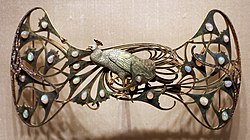
In the 1890s, jewellers began to explore the potential of the growing Art Nouveau style and the closely related German Jugendstil, British (and to some extent American) Arts and Crafts Movement, Catalan Modernisme, Austro-Hungarian Sezession, Italian "Liberty", etc.
Art Nouveau jewellery encompassed many distinct features including a focus on the female form and an emphasis on colour, most commonly rendered through the use of enamelling techniques including basse-taille, champleve, cloisonné, and plique-à-jour. Motifs included orchids, irises, pansies, vines, swans, peacocks, snakes, dragonflies, mythological creatures, and the female silhouette.
René Lalique, working for the Paris shop of Samuel Bing, was recognised by contemporaries as a leading figure in this trend. The Darmstadt Artists' Colony and Wiener Werkstätte provided perhaps the most significant input to the trend, while in Denmark Georg Jensen, though best known for his Silverware, also contributed significant pieces. In England, Liberty & Co., (notably through the Cymric designs of Archibald Knox) and the British arts & crafts movement of Charles Robert Ashbee contributed slightly more linear but still characteristic designs. The new style moved the focus of the jeweller's art from the setting of stones to the artistic design of the piece itself. Lalique's dragonfly design is one of the best examples of this. Enamels played a large role in technique, while sinuous organic lines are the most recognisable design feature.
The end of World War I once again changed public attitudes, and a more sober style developed.[46]
The Dragonfly brooch; by René Lalique; circa 1897–1898; gold, vitreous enamel, chrysoprase, chalcedony, moonstone and diamond; height: 23 cm, width: 26.5 cm; Calouste Gulbenkian Museum (Lisboa, Portugal)
Necklace; by René Lalique; 1897–1899; gold, enamel, opals and amethysts; overall diameter: 24.1 cm; Metropolitan Museum of Art (New York City)
Hair ornament, an Art Nouveau masterpiece; by René Lalique; circa 1902; gold, emeralds and diamonds; Musée d'Orsay (Paris)
Art Decoedit
Growing political tensions, the after-effects of the war, and a reaction against the perceived decadence of the turn of the 20th century led to simpler forms, combined with more effective manufacturing for mass production of high-quality jewellery. Covering the period of the 1920s and 1930s, the style has become popularly known as Art Deco. Walter Gropius and the German Bauhaus movement, with their philosophy of "no barriers between artists and craftsmen" led to some interesting and stylistically simplified forms. Modern materials were also introduced: plastics and aluminium were first used in jewellery, and of note are the chromed pendants of Russian-born Bauhaus master Naum Slutzky. Technical mastery became as valued as the material itself. In the West, this period saw the reinvention of granulation by the German Elizabeth Treskow, although development of the re-invention has continued into the 1990s. It is based on the basic shapes.
Asiaedit
In Asia, the Indian subcontinent has the longest continuous legacy of jewellery making anywhere, Asia was the first place where these jewellery were made in large numbers for the royals[citation needed] with a history of over 5,000 years.[47] One of the first to start jewellery making were the peoples of the Indus Valley civilization, in what is now predominately modern-day Pakistan and part of northern and western India. Early jewellery making in China started around the same period, but it became widespread with the spread of Buddhism around 2,000 years ago.
Chinaedit
The Chinese used silver in their jewellery more than gold. Blue kingfisher feathers were tied onto early Chinese jewellery and later, blue gems and glass were incorporated into designs. However, jade was preferred over any other stone. The Chinese revered jade because of the human-like qualities they assigned to it, such as its hardness, durability, and beauty.[8] The first jade pieces were very simple, but as time progressed, more complex designs evolved. Jade rings from between the 4th and 7th centuries BC show evidence of having been worked with a compound milling machine, hundreds of years before the first mention of such equipment in the west.[48]
In China, the most uncommon piece of jewellery is the earring, which was worn neither by men nor women.[49] In modern times, earrings are still considered culturally taboo for men in China—in fact, in 2019, the Chinese video streaming service iQiyi began blurring the ears of male actors wearing earrings. Amulets were common, often with a Chinese symbol or dragon. Dragons, Chinese symbols, and phoenixes were frequently depicted on jewellery designs.
The Chinese often placed their jewellery in their graves. Most Chinese graves found by archaeologists contain decorative jewellery.[50]
- Zdroj:https://en.wikipedia.org?pojem=Jewellery
>Text je dostupný pod licencí Creative Commons Uveďte autora – Zachovejte licenci, případně za dalších podmínek. Podrobnosti naleznete na stránce Podmínky užití.
Text je dostupný za podmienok Creative
Commons Attribution/Share-Alike License 3.0 Unported; prípadne za ďalších
podmienok.
Podrobnejšie informácie nájdete na stránke Podmienky
použitia.

